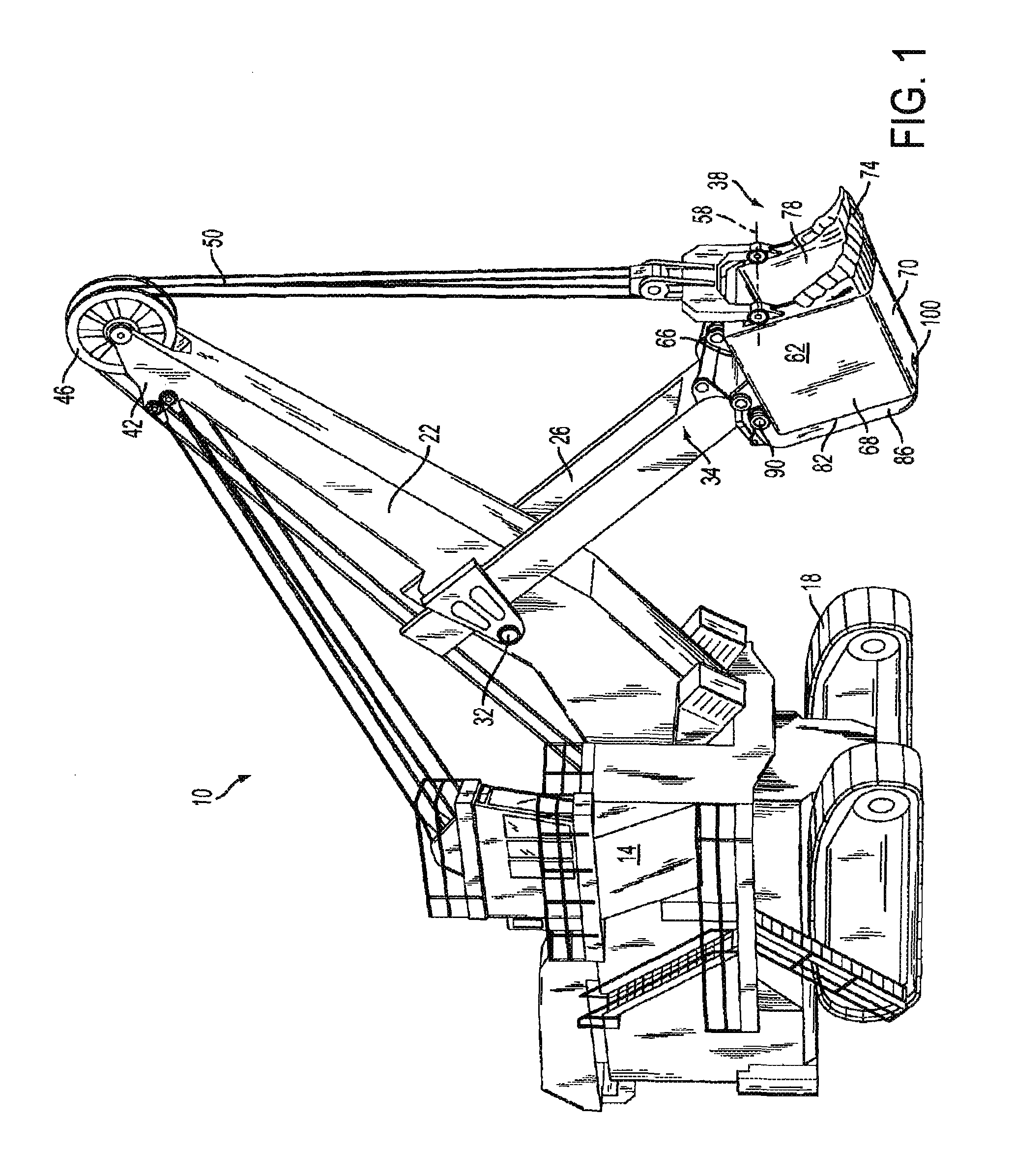Dipper door latch with locking mechanism
a technology of latches and dippers, which is applied in the direction of fastening means, mechanical machines/dredgers, constructions, etc., can solve the problems of constant replacement of ropes, broken pull chains and clevises, and significant maintenance costs of dipper latches and related operating equipment, so as to reduce lubricated rotational friction and less force
- Summary
- Abstract
- Description
- Claims
- Application Information
AI Technical Summary
Benefits of technology
Problems solved by technology
Method used
Image
Examples
first embodiment
[0054]In one embodiment, as illustrated in FIGS. 5, 6 and 7, the hold open mechanism 120 and locking mechanism 124 is a hydraulic cylinder assembly 128 pivotally attached to and extended between the dipper door 86 and the latch jaw 104. More particularly, as illustrated in FIGS. 5 and 6, the hydraulic cylinder assembly 128 is pivotally attached at one end between two of the support ribs 116.
[0055]The hydraulic assembly 128 is provided with a hydraulic cylinder 132 and a piston 134 that is movable within the hydraulic cylinder 132. The piston 134 divides the hydraulic cylinder 132 into a first chamber and a second chamber wherein the volumes of the chambers change as the piston 134 moves back and forth within the hydraulic cylinder 132. Either the hydraulic cylinder 132 or the piston 134 can be connected to the latch and the other connected to the dipper door 86.
[0056]More particularly, in this embodiment (as shown in FIG. 7), the hold open mechanism 120 and locking mechanism 124 inc...
second embodiment
[0061]In another embodiment, shown in FIGS. 9 through 16, like numerals identify items described previously. As illustrated in FIGS. 11 and 12, the locking mechanism 124 in this embodiment includes a primary locking mechanism 160 including one bar 164 pivotally attached at 165 to the door 86, and another connecting bar 168 pivotally connected to and extending between each of the one bar 164 at 166 and the latch jaw 104 at 167. The latch jaw 104 is pivotally connected to the door 86 at 169. Further, the hold open mechanism 120 in this embodiment is means biasing the latch jaw 104 into its open position in the form of a tension spring 172 attached between the one bar 164 and the connecting bar 168. More particularly, in this embodiment, there is one spring 172 on one side of the one bar 164 and the connecting bar 168 and a similar spring (see FIG. 12) on the opposite side of the one bar 164 and the connecting bar 168. When locking the locking mechanism 124, the pivot connection 166 be...
third embodiment
[0084]A further and preferred embodiment of the latch mechanism is illustrated in FIG. 18. In this embodiment, additional bumper stops have been added. More particularly, a bumper stop 201a has been added to the top protective cover 173, and another bumper stop 201c has been added to the dipper door 86 underneath the bar end 200, so that as the pivot connection 166 between the two bars moves, the ends of travel contact the bumper stops 201a and 201c, and absorb energy within the pivot connection 166. Furthermore, a bumper stop 201d has been added to the top of the bar 164 so that, when the bar 164 contacts the upper protective cover 173, energy is absorbed by the bumper stop 201d.
[0085]In another and preferred embodiment, the secondary latch mechanism further includes a false latch preventing mechanism 298, shown in FIG. 21. More particularly there are times where, when material hits the latch jaw 104, the latch mechanism may rotate to the latch closed position even though the dipp...
PUM
 Login to View More
Login to View More Abstract
Description
Claims
Application Information
 Login to View More
Login to View More - R&D
- Intellectual Property
- Life Sciences
- Materials
- Tech Scout
- Unparalleled Data Quality
- Higher Quality Content
- 60% Fewer Hallucinations
Browse by: Latest US Patents, China's latest patents, Technical Efficacy Thesaurus, Application Domain, Technology Topic, Popular Technical Reports.
© 2025 PatSnap. All rights reserved.Legal|Privacy policy|Modern Slavery Act Transparency Statement|Sitemap|About US| Contact US: help@patsnap.com



